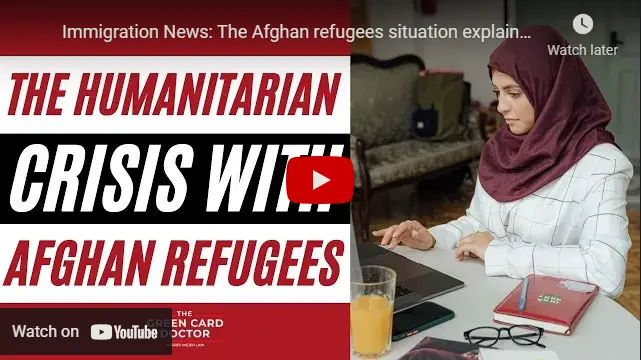Afghan Refugees Coming to America
The U.S. withdrawal from Afghanistan has provoked a series of issues in both countries, and today we’ll talk about the Afghan refugees coming to America and next week will discuss refugees coming to our Southern Border.
This is an important topic because the humanitarian situation happening with the Afghan people is an urgent matter.
If you add that to the current issues and delays the immigration system is facing, it can worsen an already overloaded system.
The U.S. Refugee Act
Our first topic for today is the situation in Afghanistan. I want to talk about the situation of Afghan refugees and immigrants coming to the U.S. after our presence there has officially ended.
First, let get some background to better understand the law.
The U.S. Refugee Act of 1980 standardized the procedures for admitting refugees – people who have fled war, violence, conflict or, persecution – and put in place a rigorous vetting process.
This act allowed 200,000 refugees to be accepted into the country that year, but over the past 40 years, the number of refugees accepted has been fallen dramatically to the point where only 50,000 refugees were accepted in 2019.
During the past 20 years, the U.S. has admitted a bit more than 20,000 Afghan refugees, giving us an average of roughly 1,000 refugees per year.
And to make things worse, due to the covid pandemic, the Trump-era restrictions, and the increasing backlog in the immigration system, during the Fiscal Year 2020-21, just 11,800 refugees from around the world settled in the U.S. – among them were only 495 Afghan Special Immigrant Visa recipients.
The number of refugees accepted seems tiny if you consider that there are approximately 70,000 Afghans who worked with US troops, 50,000 who worked for organizations supported by the US gov’t, and another 145,000 who are at risk, according to the Association of Wartime Allied.
These types of visas are part of a special program created to protect Afghans who risked their lives working for U.S. troops in Afghanistan.
Each visa recipient can bring their spouse and children and they can be eligible for a Green Card and U.S. citizenship in the future.
The total amount of SIV created is 34,500, meaning that there are more applicants than visas, so the most likely scenario is that they will be looking for humanitarian parole.
The negative part of this is that humanitarian parole doesn’t have a separate path to a green card or U.S. citizenship, so their only option would be to go through the asylum process to become eligible for a green card.
That’s some background on the law and the options they have, to come into the country.
The U.S. withdrawal from Afghanistan
But since it was announced that the U.S. would leave Afghanistan the situation with refugees and people trying to leave the country has been very difficult.
Since the Kabul airlift began, almost 124,334 people were evacuated since the govt fell on August 14, 2021, including 21,600 in a 24 hour period.
State Department spokesperson Ned Price told reporters that a total of 31,107 evacuees arrived in the U.S. between Aug. 17 and Aug. 31.
Of those people, 23,876 were “Afghans at risk,” making it up to 77% of those who entered the country.
He didn’t give exact numbers of how many of those people had a Special Immigration Visa, or another kind of visa, but he did mention that “many of them” will be SIV holders.
What will happen when the refugees get to the U.S.?
That brings us to another major point, where will the Afghan refugees go once they arrive in the U.S.?
At this moment, the evacuated Afghans will be housed at 8 different military installations throughout the country.
These installations include:
- Fort Lee, Virginia
- Fort McCoy, Wisconsin
- Fort Bliss, Texas, and
- Joint Base McGuire-Dix-Lakehurst, New Jersey
Once they are processed, refugee response groups are contacted that help the refugees get situated in a city of their choice.
There are about 200 refugee resettlement non-profits around the country.
Like refugees, special immigrants get government-funded social programs for a limited time, like cash and medical assistance, case management, and educational services to learn English.
Refugee resettlement agencies that work with the government also help them find affordable housing, career training, and jobs.
California, Utah, Texas, Virginia, and Washington are the states that have received the most special immigrants from Afghanistan since October 2020.
Now, along with the challenges that their resettlement brings, there are other factors to consider with this situation. For instance, a lot of the refugees coming in have varying legal statuses. Some are eligible for the Special Immigrant Visa program.
But there’s also a Priority-2 designation, that was created at beginning of August by the State Department, to expand access to the refugee program to Afghans who assisted U.S. contractors, media, or government programs but did not qualify for an SIV.
And then there are those individuals without visas, including those who are waiting for their SIV or designation to be processed, and who can request humanitarian parole.
Special Immigrant Visas
I want to go into more detail about the 2 main paths Afghan refugees can take when coming to the U.S.: The Special Immigrant Visa and the Humanitarian Parole.
The Special Immigrant Visa, like I mentioned earlier, is a program created for Afghan nationals who meet certain requirements and who were employed in Afghanistan:
- First, they need to be Afghan Nationals
- They must have been employed in Afghanistan for at least one year between October 7, 2001, and December 31, 2023, for the U.S. government or the International Security Assistance Force (ISAF), or a successor mission, and
- They were either translators or performed activities for the US military or ISAF.
- Applicants must also have experienced or been experiencing an ongoing serious threat because of their employment.
- Fnally, they must apply no later than December 31, 2023.
In July 2021, the Emergency Security Supplemental Appropriations Act authorized 8,000 additional SIVs for Afghan applicants, raising the number to a total of 34,500 visas allocated since December 2014.
This program will end when all visas have been issued.
At Andres Mejer Law, we will be volunteering to help the Afghans stationed at the joint base Ft. Dix McGuire Air force base. Doing what we do best, evaluating their options, and reviewing or preparing their applications.
Humanitarian Parole
Now, talking about parole, this is a temporary discretionary authorization to enter the United States that can be granted based on humanitarian or significant public benefit reasons.
Any individual can request humanitarian parole, but in this case, Afghan nationals applying should write “Afghanistan Humanitarian Parole” on the mailing envelope as well as writing “EXPEDITE REQUESTED” on the upper right corner of the application or cover letter. This could help them get their application processed more quickly.
Typically, parole is granted for no more than one year, but the DHS has indicated that parole can be granted for certain Afghan nationals for a period of two years given the circumstances.
As I mentioned earlier, people who request humanitarian parole would not be able to apply for a green card or U.S. citizenship but added to that, there are other downfalls of requesting parole.
For instance, at the end of their parole period, they would need to leave the country if they have not successfully applied for a visa or otherwise legalized their immigration status.
Under the status of parole, they do not have access to the same resettlement services as SIV applicants, ranging from cash and medical assistance to health insurance to help with housing.
The only support they would get is a one-time per capita payment that the State Department provides to resettlement agencies to care for people, which is about $400 per person, which is not much.
Talk to a New Jersey Immigration Attorney
And with that, we arrive at the end of this article. This is an important topic to cover because it will have a huge humanitarian impact and it can help set precedents on future immigration issues.
If you have any questions about what we just talked about, any comments, or doubts, please leave them below and we’ll do our best to get back to you.
Or if you want to talk about your immigration status and want to discuss your case, reach to us, and our New Jersey immigration attorneys be glad to talk to you and find the best path to your legal status.
Remember, if we can’t help you, we won’t take your money.
As always, stay healthy and be well.




